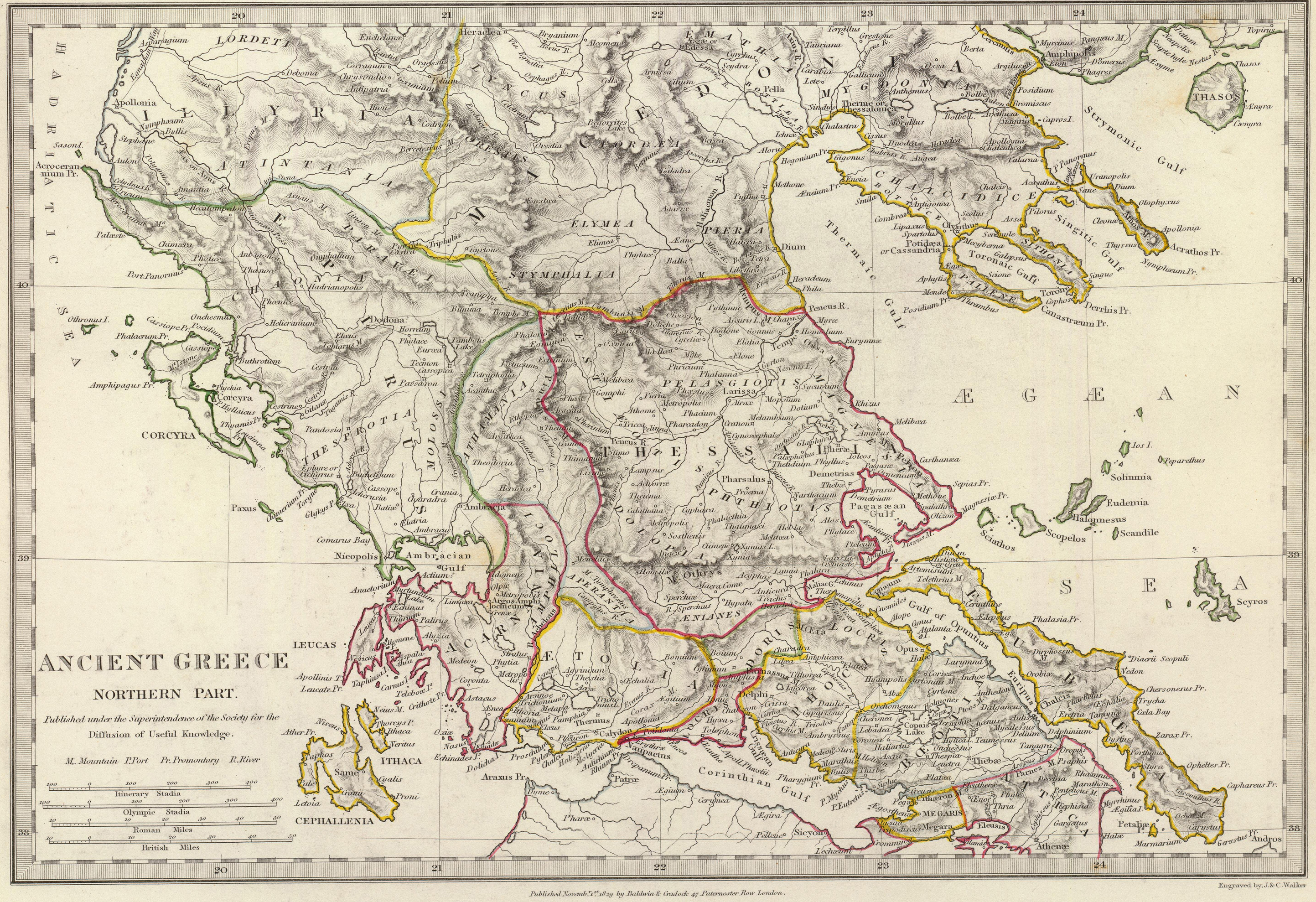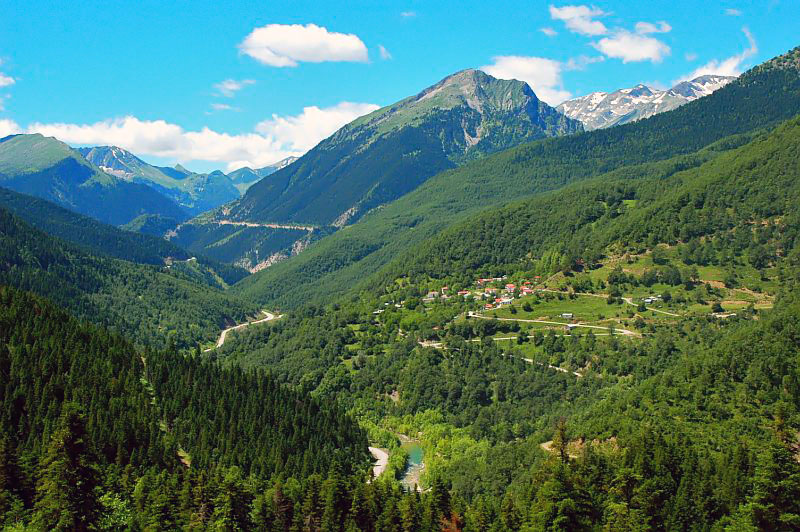|
Histiaeotis
Histiaeotis () or ''Hestiaeotis'' (Ἑστιαιῶτις - Hestiaiotis) was a northwest district of ancient Thessaly, part of the Thessalian tetrarchy, roughly corresponding to the modern Trikala regional unit. Anciently, it was inhabited by the Hestiaeotae (Ἑστιαιῶται), and the Peneius may be described in general as its southern boundary. It occupied the passes of Mount Olympus, and extended westward as far as Pindus. The demonym of the district's inhabitants is Histiaeotes (Ἱστιαιῶται, ''Histiaiotai''). In epigraphy, the regional name occurs as ''Hestiotai'', ambassadors in Athens and Histiotai in the Thessalian grain decree for Rome (see Pelasgiotis) but most similarly written names are related to Histiaea, an Attic deme and a city in North Euboea. The epigraphical Aeolic Greek vocalism of Hestiaeotis is bizarre and idiomatic. Histiaeotis is first mentioned by Herodotus, when''.. in the time of Dorus the son of Hellen, (Dorians) were in the ter ... [...More Info...] [...Related Items...] OR: [Wikipedia] [Google] [Baidu] |
Oreus
Oreus or Oreos (), prior to the 5th century BC called Histiaea or Histiaia (Ἱστίαια), also Hestiaea or Hestiaia (Ἑστίαια), was a town near the north coast of ancient Euboea, situated upon the river Callas, at the foot of Mount Telethrium, and opposite Antron on the Thessalian coast. From this town the whole northern extremity of Euboea was named Histiaeotis (Ἱστιαιῶτις, ) According to some it was a colony from the Attic deme of Histiaea; according to others it was founded by the Thessalian Perrhaebi. Another foundation story had it that the name Histiaea is said to derive from the mythical figure Histiaea, the daughter of Hyrieus. It was one of the most ancient of the Euboean cities. It occurs in the Catalogue of Ships in the ''Iliad'', where Homer gives it the epithet of πολυστάφυλος (rich in grapes); and the ''Periplus of Pseudo-Scylax'' mentions it as one of the four cities of Euboea. It was an important city in classical antiq ... [...More Info...] [...Related Items...] OR: [Wikipedia] [Google] [Baidu] |
Ancient Thessaly
Thessaly or Thessalia (Attic Greek: , ''Thessalía'' or , ''Thettalía'') was one of the traditional regions of Ancient Greece. During the Mycenaean Greece, Mycenaean period, Thessaly was known as Aeolia, a name that continued to be used for one of the major tribes of Greece, the Aeolians, and their dialect of Greek, Aeolic Greek, Aeolic. Geography At its greatest extent, ancient Thessaly was a wide area stretching from Mount Olympos, Mount Olympus to the north to the Spercheios Valley to the south. Thessaly is a geographically diverse region, consisting of Thessalian plain, broad central plains surrounded by mountains. The plains are bounded by the Pindos Mountains to the west, Mount Othrys to the south, the Pelion and Mount Ossa (Greece), Ossa ranges to the east, and Mount Olympos to the North. The central plains consist of two basins, the Larissa, Larisa basin and the Karditsa basin, drained by the Pineios (Thessaly), Pineios River into the Vale of Tempe. The Pagasetic Gulf in s ... [...More Info...] [...Related Items...] OR: [Wikipedia] [Google] [Baidu] |
Pelasgiotis
Pelasgiotis () was an elongated district of ancient Thessaly, extending from the Vale of Tempe in the north to the city of Pherae in the south. The Pelasgiotis included the following localities: Argos Pelasgikon, Argyra, Armenium, Atrax, Crannon, Cynoscephalae, Elateia, Gyrton, Mopsion, Larissa, Kondaia, Onchestos river and town, Phayttos, Pherae, Scotussa, and Sykourion. The demonym of the district's inhabitants is Pelasgiotae or Pelasgiotes (Πελασγιῶται, ''Pelasgiōtai''). Along with Achaea Phthiotis, Thessaliotis and Histiaeotis, the Pelasgiotis comprised the Thessalian tetrarchy, governed by a ''tagus'', when occasion required. The territory is mentioned by Strabo but not by Herodotus, who seems to include it in the district of Thessaliotis. In epigraphy, Pelasgiotes are mentioned among other Thessalian ambassadors in Athens . A fragment of a marble stele at Larissa records that on request of the Roman consul Quintus Caecilius Metellus, son of Quintu ... [...More Info...] [...Related Items...] OR: [Wikipedia] [Google] [Baidu] |
Perrhaebians
The Perrhaebi () were an ancient Greek people who lived on the western slopes of Olympus, on the border between Thessaly and Macedonia. They took part in the Trojan War under Guneus and also fought in the Battle of Thermopylae. History Still independent at the time of the ''Iliad'', they were tributary ''períoikoi'' to the neighbouring Thessali in the 5th century BC, with a special dependence upon the city of Larisa. They could, however, enjoy some degree of autonomy whenever the Thessalian League was weaker, and they had retained from their independence two votes in the Delphic Amphictyonic League (''Amphiktyonía''), until Philip II of Macedon took one vote from them. They were part of the Macedonian Kingdom until the Roman conquest by Titus Quinctius Flamininus in 196 BC. They were listed in Xerxes' vast army by Herodotus. A coin of the Perrhaebi depicted a man restraining a bull on one side and a horse on the other. The inscription was "Περραιβών".Handbook of ... [...More Info...] [...Related Items...] OR: [Wikipedia] [Google] [Baidu] |
Strabo
Strabo''Strabo'' (meaning "squinty", as in strabismus) was a term employed by the Romans for anyone whose eyes were distorted or deformed. The father of Pompey was called "Gnaeus Pompeius Strabo, Pompeius Strabo". A native of Sicily so clear-sighted that he could see things at great distance as if they were nearby was also called "Strabo". (; ''Strábōn''; 64 or 63 BC) was an ancient Greece, ancient Greek geographer who lived in Anatolia, Asia Minor during the transitional period of the Roman Republic into the Roman Empire. He is best known for his work ''Geographica'', which presented a descriptive history of people and places from different regions of the world known during his lifetime. Additionally, Strabo authored historical works, but only fragments and quotations of these survive in the writings of other authors. Early life Strabo was born to an affluent family from Amasya, Amaseia in Kingdom of Pontus, Pontus in around 64BC. His family had been involved in politics s ... [...More Info...] [...Related Items...] OR: [Wikipedia] [Google] [Baidu] |
Thesprotia
Thesprotia (; , ) is one of the regional units of Greece. It is part of the Epirus region. Its capital and largest town is Igoumenitsa. Thesprotia is named after the Thesprotians, an ancient Greek tribe that inhabited the region in antiquity. History Thesprotia was part of the proto-Greek region in the late Bronze Age in which Greek archaic toponyms are densely found. In antiquity, the territory of modern Thesprotia was inhabited by the ancient Greek tribe of Thesprotians and was bordered by the neighboring regions of Molossia to the north and Chaonia to the east. Thesprotia is mentioned at the Epic Cycle as a place where Odysseus sailed and married the local queen Callidice of Thesprotia. Thesprotia became part of the Epirote League before it was annexed by Rome where it became part of the Roman province of Epirus. After the fragmentation of the Roman Empire into East and West, it was part of the Eastern Roman (Byzantine) Empire until the late Middle Ages, except for a peri ... [...More Info...] [...Related Items...] OR: [Wikipedia] [Google] [Baidu] |
Thessalian
Thessaly ( ; ; ancient Thessalian: , ) is a traditional geographic and modern administrative region of Greece, comprising most of the ancient region of the same name. Before the Greek Dark Ages, Thessaly was known as Aeolia (, ), and appears thus in Homer's ''Odyssey''. Thessaly became part of the modern Greek state in 1881, after four and a half centuries of Ottoman rule. Since 1987 it has formed one of the country's 13 regions and is further (since the Kallikratis reform of 2011) sub-divided into five regional units and 25 municipalities. The capital of the region is Larissa. Thessaly lies in northern central Greece and borders the regions of Macedonia to the north, Epirus to the west, Central Greece to the south, and the Aegean Sea to the east. The Thessaly region also includes the Sporades islands. Name and etymology Thessaly is named after the ''Thessaloi'', an ancient Greek tribe. The meaning of the name of this tribe is unknown, and many theories have been ma ... [...More Info...] [...Related Items...] OR: [Wikipedia] [Google] [Baidu] |
Lapithae
The Lapiths (; , ''Lapithai'', sing. Λαπίθης) were a group of legendary people in Greek mythology, who lived in Thessaly in the valley of the Pineios and on the mountain Pelion. They were believed to have descended from the mythical Lapithes, brother of Centaurus, with the two heroes giving their names to the races of the Lapiths and the Centaurs respectively. The Lapiths are best known for their involvement in the ''Centauromachy'' (), a mythical fight that broke out between them and the Centaurs during Pirithous and Hippodamia's wedding. Mythology Origin The Lapiths were an Aeolian tribe who, like the Myrmidons, were natives of Thessaly. The genealogies make them a kindred people with the centaurs: In one version, Lapithes (Λαπίθης) and Centaurus (Κένταυρος) were said to be twin sons of the god Apollo and the nymph Stilbe, daughter of the river god Peneus. Lapithes was a valiant warrior, but Centaurus was a deformed being who later mated with mares ... [...More Info...] [...Related Items...] OR: [Wikipedia] [Google] [Baidu] |
Mount Pindus
The Pindus (also Pindos or Pindhos; ; ; ) is a mountain range located in Northern Greece and Southern Albania. It is roughly long, with a maximum elevation of (Mount Smolikas). Because it runs along the border of Thessaly and Epirus, the Pindus range is known colloquially as the ''spine of Greece''. The mountain range stretches from near the Greek-Albanian border in southern Albania, entering the Epirus and Macedonia regions in northern Greece down to the north of the Peloponnese. Geologically, it is an extension of the Dinaric Alps, which dominate the western region of the Balkan Peninsula. History of the name Historically, the name Pindos refers to the mountainous territory that separates the greater Epirus region from the regions of Macedonia and Thessaly. According to John Tzetzes (a 12th-century Byzantine writer), the Pindos range was then called Metzovon. When translated (between 1682/83 and 1689) to a more conversational (colloquial) language the initial praise to ... [...More Info...] [...Related Items...] OR: [Wikipedia] [Google] [Baidu] |
Lake Boebeis
Boebeis Lake (Βοιβηΐς λίμνη, Βοιβία λίμνη, and Βοιβιάς λίμνη) was a lake of Magnesia in ancient Thessaly, mentioned by Homer, and named for the town ( Boebe) on its southeastern shore. The lake is frequently mentioned by the ancient writers. It received the rivers Onchestus, Amyrus, and several smaller streams, but had no outlet for its waters. From its proximity to Mount Ossa, it is called ''Ossaea Boebeis'' by Lucan. Athena is said to have bathed her feet in its waters, which is perhaps the reason why Propertius speaks of ''sanctae Boebeidos undae''.Propertius, 2.2.11. The lake was a long narrow piece of water, and is now called Lake Karla Lake Karla () is a lake that sits at above sea level making it the only one in the plain of Thessaly. The lake is located at the northern end of the Magnesia regional unit in the Pineios basin, adjacent to Pelion and the Maurovouni mountains. ... from a village which has disappeared. References ... [...More Info...] [...Related Items...] OR: [Wikipedia] [Google] [Baidu] |
Perrhaebia
Perrhaebia () was the northernmost district of ancient Thessaly, where the tribe of the Perrhaebi lived. Major cities were: Pythion, Doliche, Azorus, Oloosson and Phalanna the capital. Perrhaebia was part of Macedon Macedonia ( ; , ), also called Macedon ( ), was an ancient kingdom on the periphery of Archaic and Classical Greece, which later became the dominant state of Hellenistic Greece. The kingdom was founded and initially ruled by the royal ...ia between the 4th and 1st centuries BC. References *In the shadow of Olympus By Eugene N. Borza Page 164 Historical regions in Greece Ancient Macedonia {{AncientThessaly-geo-stub ... [...More Info...] [...Related Items...] OR: [Wikipedia] [Google] [Baidu] |








